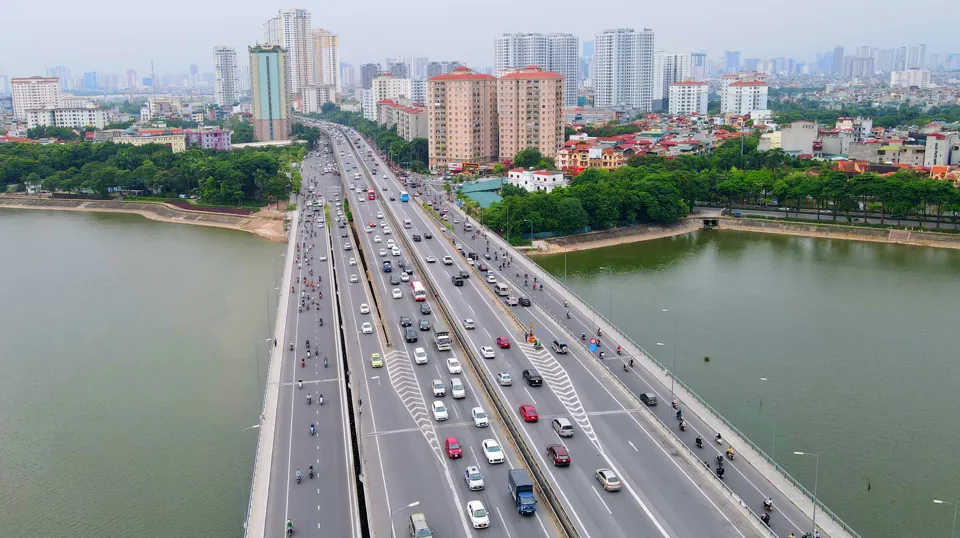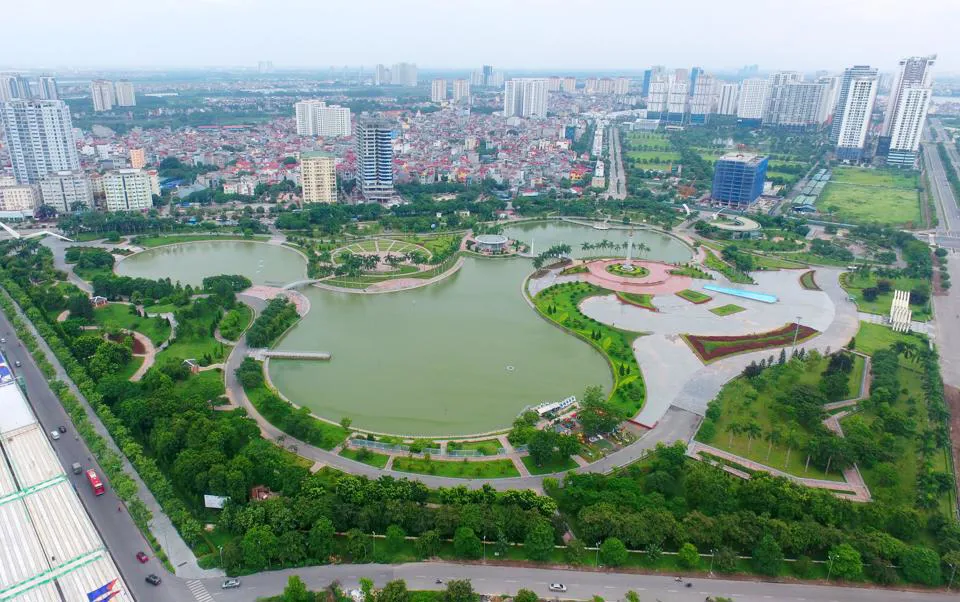Resolution 15 creates space for Hanoi's urban development
The future development of the capital's spatial landscape should be in line with the vision of a sustainable, environmentally friendly and smart city.
Hanoi’s expansion of its administrative boundary in 2008 under National Assembly Resolution 15 has provided the city with sufficient space for further growth and development.
| The elevated Ring Road No.3. Photo: Pham Hung/The Hanoi Times |
Three years later, on July 26, 2011, the Prime Minister issued Decision 1259/QD-TTg, which outlined the construction plan for the capital until 2030, with a vision until 2050. The goal was to build a capital characterized by its "Green - Civilized - Modern" approach, aiming to become a vibrant metropolis with an optimal quality of life and working environment while offering favorable investment prospects.
Long-term vision in organizing urban spaces
In the 12 years since the implementation of Decision 1259, significant achievements have been made, but some shortcomings and challenges have also been identified.
In addition, a number of strategic development frameworks have been devised, including Politburo Resolution 06-NQ/TW, which deals with the planning, construction, management, and sustainable development of urban zones in Vietnam, and Resolution 15-NQ/TW, which details the directions and tasks for the development of the capital up to 2030, with a vision up to 2045.
In light of these factors, Hanoi has meticulously overseen the assessment of Decision 1259's execution and the task of adjusting the master plan for the forthcoming period.
Recently, the Prime Minister issued Decision 700/QD-TTg, approving the initiative to revise the Capital Master Plan until 2045, with a vision until 2065.
This adjustment includes extending the timeframe for reviewing and amending the Capital Master Plan in conjunction with the preparation of the Capital Master Plan up until 2045, with a vision of 2050. According to experts, the city needs a revolutionary approach to research and planning that requires multidisciplinary collaboration and the harnessing of the capital's collective expertise and insights.
Given the synchronized prerequisites, the issue of structuring the physical landscape of the capital city within its development trajectory is a key consideration, constituting the initial phase of integrating prerequisites from different sectors and domains.
In line with the guidelines of Decision 1259, Hanoi's development follows an urban cluster model. This model comprises a central urban zone, five satellite cities, eco-cities, towns, and rural areas interconnected by green corridors and wedges, all linked by a network of ring roads and radial axes.
This model, often successful in developed countries, is well suited to Hanoi's unique characteristics and has been imbued with creative adaptations evident in approved local plans.
However, the results of implementation have shown that the given spatial framework has not been optimally utilized. The development of satellite towns, townships, and eco-cities has been sluggish due to delayed infrastructure development and inadequate establishment of appropriate urban management protocols.
In areas designated for new rural development (green corridors), issues have arisen regarding the conversion of agricultural land and the preservation of natural and distinctive landscapes.
The intended functionality of green belts and wedges has not been fully realized. Some new urban enclaves have developed independently, lacking critical linkages. The creation of satellite cities has been hampered by inadequate mechanisms and policies to encourage business participation and innovation.
Decision 1259 builds on previous plans and outlines the spatial configuration of the central urban area, which includes the historic downtown, the expanded downtown, the urban chain north of the Red River, and the urban zones within Ring Road No.4.
However, the spatial arrangement of various zones has faced challenges due to rapid population growth. At the same time, the process of rezoning industrial facilities, hospitals, universities, and other institutions has not been in line with the original plan. In particular, the northern area of the Red River and the region east of Ring Road No.4 have struggled to attract investment, resulting in the underutilization of available land resources.
Decision 1259 has also outlined significant spatial axes, each of which serves different functions. Notable examples include the Red River as the central landscape axis of the city, the My Dinh - Huong Son - Ba Vi economic spatial axis, the West Lake - Ba Vi traditional cultural spatial axis (connecting the cultural heritage of Thang Long and Doai), the Ha Dong - Chuong My - Xuan Mai landscape spatial axis, the scientific spatial axis connecting the central urban region with Hoa Lac, and the spiritual spatial axis between the West Lake and Co Loa.
Complementing these functional spatial axes are the radial transport axes, which play a key role in connecting the transport network and the surrounding regions through a road system. This network includes 18 road bridges over the Red River, eight bridges over the Duong River, eight radial axes, five ring roads, eight urban rail lines, and an integrated airport system.
| Hoa Binh Park in Hanoi. Photo: Pham Hung/The Hanoi Times |
Promotion of green and sustainable urban spaces
The future development of the capital's spatial landscape should be in line with the vision of a sustainable, environmentally friendly, and intelligent city. This approach involves reconciling economic progress with the preservation of ecological integrity and traditional cultural values.
While the urban cluster development model has many advantages and practicality, it requires a rational determination of scale and a well-defined development roadmap backed by diversified investment resources. It also requires attention to the reform of administrative units, especially those designated as cities within the capital and new townships.
Within the central urban zone, the delineation of distinct areas such as the Old Quarter, the historic core of Ba Dinh, the Hoan Kiem Lake area, and the West Lake region is essential for effective cultural space management and the preservation of traditions.
A major focus in the coming phase will be to establish the Red River acting as the city's central landscape axis, ensuring balanced development on both sides. At the same time, a strategic roadmap for the development of other river-based axes such as the Duong River, Da River, To Lich River, Kim Nguu River, and Nhue River needs to be established in order to harmonize the creation of green corridors and cultivate traditional cultural spaces along the Ba Vi - West Lake and West Lake - Co Loa axes.
The comprehensive spatial organization of the capital city requires a well-defined public transportation system, with special emphasis on urban railway lines. This orientation is essential for logical spatial development based on regions, routes, and strategically positioned Transit-Oriented Development (TOD) points. The advancement of a modernized environment requires the establishment of a science, technology, and education axis connecting Hoa Lac City with the central district and the northern region, as well as the timely construction of a smart city axis (Nhat Tan - Noi Bai).
Radial traffic axes have been established to connect Hanoi with its neighboring areas, creating a modern and versatile environment. The ongoing construction of the Ring Road No. 4 axis improves regional connectivity; however, it is crucial to identify priority projects on both sides of this route to showcase the essence of a modern capital city.
This adjustment of the master plan for the spatial organization of the capital not only extends the vision in accordance with Decision 1259 but also entails a better recognition of the progress made in the past 12 years. It mandates the identification of crucial facets of spatial organization, urban aesthetics, distinct areas, and prominent spatial axes.
A comprehensive refinement of the adjustment of the Capital Master Plan, coupled with the Capital Planning endeavor and the revised Capital Law, is anticipated. This will lay the groundwork for orchestrating the construction and development of the capital, bringing it in line with regional and global standards. Importantly, this approach will leave an indelible mark of traditional historical and cultural identity.













